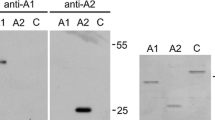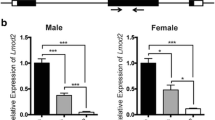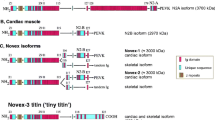Abstract
We evaluated the effect of shz-1, a cardiogenic molecule, on the expression of various tropomyosin (TM) isoforms in the Mexican axolotl (Ambystoma mexicanum) hearts. qRT-PCR data show a ~1.5-fold increase in cardiac transcripts of the Nkx2.5 gene, which plays a crucial role in cardiogenesis in vertebrates. Shz-1 augments the expression of transcripts of the total sarcomeric TPM1 (both TPM1α & TPM1κ) and sarcomeric TPM4α. In order to understand the mechanism by which shz-1 augments the expression of sarcomeric TPM transcription in axolotl hearts, we transfected C2C12 cells with pGL3.axolotl. We transfected C2C12 cells with pGL3-axolotl TPM4 promoter constructs containing the firefly luciferase reporter gene. The transfected C2C12 cells were grown in the absence or presence of shz-1 (5 μM). Subsequently, we determined the firefly luciferase activity in the extracts of transfected cells. The results suggest that shz-1 activates the axolotl TPM4 promoter-driven ectopic expression in C2C12 cells. Also, we transfected C2C12 cells with a pGL3.1 vector containing the promoter of the mouse skeletal muscle troponin-I and observed a similar increase in the luciferase activity in shz-1-treated cells. We conclude that shz-1 activates the promoters of a variety of genes including axolotl TPM4. We have quantified the expression of the total sarcomeric TPM1 and observed a 1.5-fold increase in treated cells. Western blot analyses with CH1 monoclonal antibody specific for sarcomeric isoforms show that shz-1 does not increase the expression of TM protein in axolotl hearts, whereas it does in C2C12 cells. These findings support our hypothesis that cardiac TM expression in axolotl undergoes translational control.









Similar content being viewed by others
References
Gunning, P., O’Neill, G., & Hardmen, E. (2008). Tropomyosin-based regulation of actin cytoskeleton in time and space. Physiology Review, 88, 1–35.
Lees-Miller, J., & Helfman, D. (1991). The molecular basis for tropomyosin isoform diversity. BioEssays, 13, 429–437.
Perry, S. V. (2001). Vertebrate tropomyosin, properties and function. Journal of Muscle Research and Cell Motility, 22, 5–49.
Piples, K., & Wieczorek, D. F. (2000). Tropomyosin 3 increases striated muscle isoform diversity. Biochemistry, 39, 8291–8297.
Pittenger, M. F., Kazzaz, J. A., & Helfman, D. M. (1994). Functional properties of nonmuscle tropomyosin isoforms. Current Opinion in Cell Biology, 6, 96–104.
Wieczorek, D. F. (1988). Regulation of alternatively spliced alpha-tropomyosin gene expression by nerve extract. Journal of Biological Chemistry, 263, 10456–10463.
Lemanski, L. F. (1979). Role of tropomyosin in actin filament formation in embryonic salamander heart cells. Journal of Cell Biology, 82, 227–238.
Zhang, C., Jia, P., Huang, X., Sferrazza, G. F., Athauda, G., Achary, A. P., et al. (2009). Myofibril-Inducing RNA (MIR) is essential for tropomyosin expression and myofibrillogenesis in axolotl hearts. Journal of Biomedical Sciences, 16, 81.
Spinner, B. J., Zajdel, R. W., McLean, M. D., Denz, C. R., Dube, S., Mehta, S., et al. (2002). Characterization of a TM-4 type tropomyosin that is essential for myofibrillogenesis and contractile activity in embryonic hearts of the Mexican axolotl. Journal of Cellular Biochemistry, 85, 747–761.
Zajdel, R. W., McLean, M. D., Lemanski, S. L., Muthuchamy, M., Wieczorek, D. F., Lemanski, L. F., et al. (1998). Ectopic expression of tropomyosin promotes myofibrillogenesis in mutant axolotl hearts. Developmental Dynamics, 213, 412–420.
Luque, E. A., Lemanski, L. F., & Dube, D. K. (1994). Molecular cloning, sequencing and expression of a tropomyosin form cardiac muscle of the Mexican axolotl, Ambystoma mexicanum. Biochemical and Biophysical Research Communications, 203, 319–325.
Luque, E. A., Spinner, B. J., Dube, S., Dube, D. K., & Lemanski, L. F. (1997). Differential expression of a novel isoform of alpha-tropomyosin in cardiac and skeletal muscle of the Mexican axolotl (Ambystoma mexicanum). Gene, 185, 175–180.
Schevzov, G., Whittaker, S., Fath, T., Lin, J. J.-C., & Gunning, P. W. (2011). Tropomyosin isoforms and reagents. BioArchitecture, 1, 135–164.
Zajdel, R. W., Dube, D. K., & Lemanski, L. F. (1999). The cardiac mutant Mexican axolotl is a unique animal model for evaluation of cardiac myofibrillogenesis. Experimental Cell Research, 248, 557–566.
Zajdel, R. W., McLean, M. D., Lemanski, L. F., & Dube, D. K. (2000). Alteration of cardiac myofibrillogenesis by lipofectin-mediated delivery of exogenous proteins and nucleic acids into whole embryonic hearts. Anatomy and Embryology, 210, 217–228.
Sadek, H., Hannack, B., Choe, E., Wang, J., Latif, S., Garry, M. G., et al. (2008). Cardiogenic small molecules that enhance myocardial repair by stem cells. Proceedings of the National Academy of Sciences USA, 105, 6063–6068.
Pinnamaneni, S., Dube, S., Welch, C., Shrestha, R., Benz, P. M., Abbott, L., et al. (2013). Effect of Shz-1, a cardiogenic small molecule, on expression of tropomyosin in axolotl heart. American Based Research Journal, 2, 24–40.
Schwartz, R. J., Sepulveda, J., & Belaguli, S. N. (2002). Molecular regulation of cardiac myofibrillogenesis: Roles of serum response factor, Nkx2.5, and GATA-4. In D. Dube (Ed.), Myofibrillogenesis (pp. 103–127). New York: Springer.
Tanaka, M., Kasahara, H., Bartunkova, S., Schinke, M., Komuro, I., Inagaki, H., et al. (1998). Vertebrate homologs of tinman and bagpipe: Roles of the homeobox genes in cardiovascular development. Developmental Genetics, 22, 239–249.
Thurston, H. L., Prayaga, S., Thomas, A., Guharoy, V., Dube, S., Poiesz, B. J., et al. (2009). Expression of Nkx2.5 in wild type, cardiac mutant, and thyroxine-induced metamorphosed hearts of the Mexican axolotl. Cardiovascular Toxicology, 9, 13–20.
Pffaffl, M. W. (2001). A new mathematical model for relative quantification in real time RT-PCR. Nucleic Acids Research, 29, 2002–2007.
Livak, K. J., & Schmittgen, T. D. (2001). Analysis of relative gene expression data using real-time quantitative PCR and 2-DDCT method. Methods, 25, 402–408.
Yuan, J. S., Reed, A., Chen, F., & Stewart, C. N. (2006). Statistical analysis of real-time PCR data. BMC Bioinformatics, 7, 85–101.
Thomas, A., Rajan, S., Thurston, H. L., Masineni, S. N., Dube, P., Bose, A., et al. (2010). Expression of a novel tropomyosin isoform in axolotl heart and skeletal muscle. Journal of Cellular Biochemistry, 110, 875–881.
Clemente, C. F., Corat, M. A., Saad, S. T., & Franchini, K. G. (2005). Differentiation of C2C12 myoblasts is critically regulated by FAK signaling. American Journal of Physiology: Regulatory, Integrative and Comparative Physiology, 289, R862–R870.
Denz, C. R., Zhang, C., Jia, P., Du, J., Huang, X., Dube, S., et al. (2011). Absence of mutation at the 5′-upstream promoter region of the TPM4 gene from cardiac mutant axolotl (Ambystoma mexicanum). Cardiovascular Toxicology, 11, 235–243.
Du, J., Nan, C., Huang, J. J., Zhang, C., Liu, J., Jia, P., et al. (2008). Functional characterization of mouse fetal TnI gene promoters in myocardial cells. Journal of Biomedical Science, 15, 605–613.
Nan, C., & Huang, X. (2009). Transcription factor Yin Yang 1 represses fetal troponin I gene expression in neonatal myocardial cells. Biochemical and Biophysical Research Communications, 378, 62–67.
Hardy, S., Theze, N., Lepetit, D., Allo, M. R., & Thiebaud, P. (1995). The Xenopus laevis TM-4 gene encodes non-muscle and cardiac tropomyosin isoforms through alternative splicing. Gene, 156, 265–270.
Fleenor, D. E., Hickman, K. H., Lindquester, G. J., & Devlin, R. B. (1992). Avian cardiac tropomyosin gene produces tissue-specific isoforms through alternative RNA splicing. Journal of Muscle Research & Cell Motility, 13, 55–63.
Yaffe, D., & Saxel, O. (1977). Serial passaging and differentiation of myogenic cells isolated from dystrophic mouse muscle. Nature, 270, 725–727.
Chen, C. Y., & Schwartz, R. J. (1996). Recruitment of the tinman homolog Nkx-2.5 by serum response factor activates cardiac alpha-actin gene transcription. Molecular and Cellular Biology, 16, 6372–6384.
Biben, C., & Harvey, R. P. (1997). Homeodomain factor Nk2–5 controls left/right asymmetric expression of bHLH gene eHand during murine heart development. Genes & Development, 11, 1357–1369.
Riazi, A. M., Lee, H., Hsu, C., & Arsdell, G. V. (2005). CSX/Nkx2.5 modulates differentiation of skeletal myoblasts and promotes differentiation into neuronal cells in vitro. Journal of Biological Chemistry, 280, 10716–10720.
Acknowledgments
The work in this laboratory was supported by grants from American Heart Association (both National & New York State affiliate), CNY Children’s Miracle Network, Syracuse, NY, grants from Golisano Children’s Hospital, Syracuse, NY, and funding from College of Health Professionals, Upstate Medical University, Syracuse to DKD; the Barbara Kopp Cancer Research Fund to BJP; NIH grant 1R15HL112130-01 to XH, FAU. None of the authors has any conflict of interest.
Author information
Authors and Affiliations
Corresponding author
Rights and permissions
About this article
Cite this article
Nan, C., Dube, S., Matoq, A. et al. Expression of Sarcomeric Tropomyosin in Striated Muscles in Axolotl Treated with Shz-1, a Small Cardiogenic Molecule. Cardiovasc Toxicol 15, 29–40 (2015). https://doi.org/10.1007/s12012-014-9265-z
Published:
Issue Date:
DOI: https://doi.org/10.1007/s12012-014-9265-z




